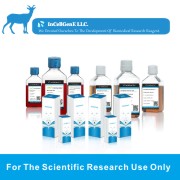

Overview
| Organism | Mus musculus, mouse |
|---|---|
| Tissue | liver |
| Cell Type | hepatocyte |
| Product Format | frozen |
| Morphology | epithelial |
| Culture Properties | adherent |
| Biosafety Level |
1
Biosafety classification is based on U.S. Public Health Service Guidelines, it is the responsibility of the customer to ensure that their facilities comply with biosafety regulations for their own country. |
| Disease | normal |
| Age | 3 months |
| Gender | male |
| Strain | CD-1 |
| Applications |
This cell line is a suitable transfection host.
|
| Storage Conditions | liquid nitrogen vapor phase |
Properties
| Derivation |
The AML12 (alpha mouse liver 12) cell line was established from hepatocytes from a mouse (CD1 strain, line MT42) transgenic for human TGF alpha.
|
|---|---|
| Clinical Data |
male
|
| Genes Expressed |
albumin; human transforming growth factor alpha (TGF alpha); mouse TGF alpha.
|
| Cellular Products |
albumin; human transforming growth factor alpha (TGF alpha); mouse TGF alpha
|
| Tumorigenic | No |
| Effects |
No, the cells do not form colonies or grow in soft agar.
No, the cells were not tumorigenic in immunosuppressed mice
|
| Comments |
The AML12 (alpha mouse liver 12) cell line was established from hepatocytes from a mouse (CD1 strain, line MT42) transgenic for human TGF alpha.
By electron microscopy, these cells exhibit typical hepatocyte features such as peroxisomes and bile canalicular like structure.
AML12 cells retain the capacity to express high levels of mRNA for serum (albumin, alpha 1 antitrypsin and transferrin) and gap junction (connexins 26 and 32) proteins, and contain solely isoenzyme 5 of lactate dehydrogenase.
The cells express high levels of human TGF alpha and lower levels of mouse TGF alpha.
Expression of liver specific proteins decreases with time in culture, but is reactivated by growing the cells in serum free medium.
|
Background
| Complete Growth Medium |
The base medium for this cell line is DMEM:F12 Medium . To make the complete growth medium, add the following component to the 500 mL of the base medium: Supplemented with:
This medium is formulated for use with a 5% CO2 in air atmosphere. |
|---|---|
| Subculturing |
Volumes used in this protocol are for 75 cm2 flask; proportionally reduce or increase amount of dissociation medium for culture vessels of other sizes.
Subcultivation Ratio: 1:4 to 1:6
Medium Renewal: 2 to 3 times a week.
Note: For more information on enzymatic dissociation and subculturing of cell lines consult Chapter 10 in Culture of Animal Cells, a manual of Basic Technique by R. Ian Freshney, 3rd edition, published by Alan R. Liss, N.Y., 1994.
|
| Cryopreservation |
Freeze medium: Complete growth medium supplemented with 5% (v/v) DMSO
Storage temperature: liquid nitrogen vapor phase
|
| Culture Conditions |
Temperature: 37��C
|


